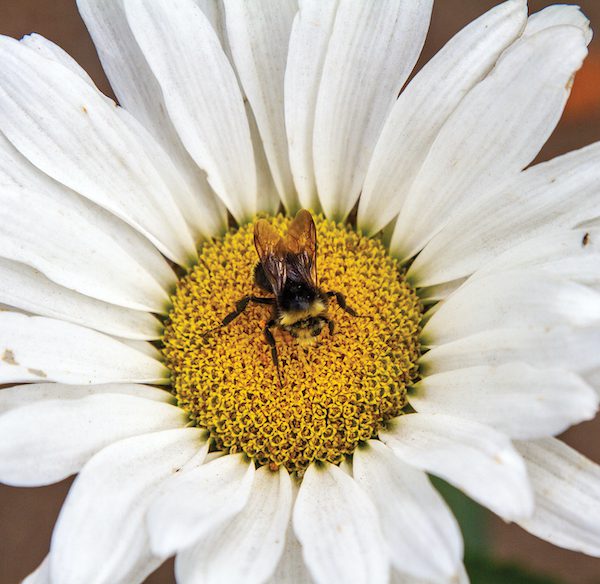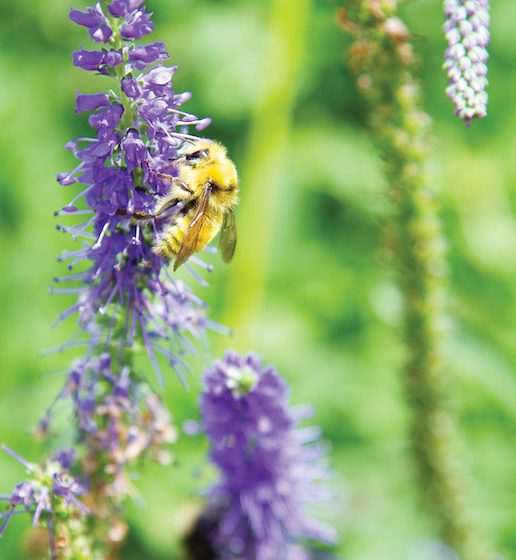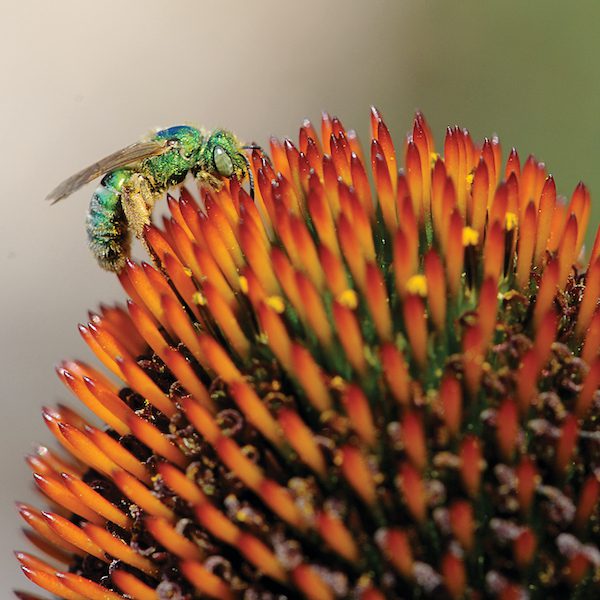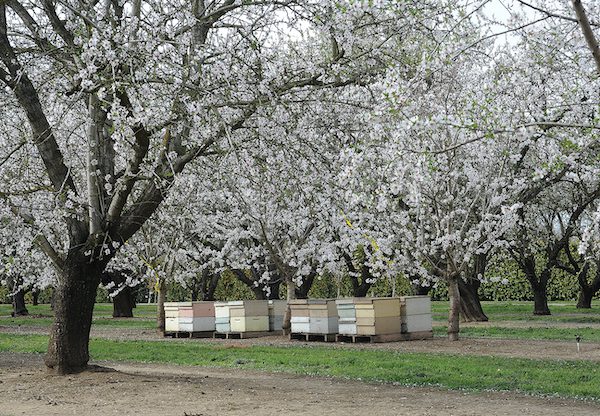
25 Sep Pollinators in Peril: California’s Native Bees Face an Uncertain Future
Bees in the Golden State and beyond are struggling as they fight climate change and other threats to survival
Imagine a baby-pool-sized bowl filled with food so irresistibly delicious that you were enticed to crawl inside and start eating it by the handful. Welcome to the messy, but undoubtedly delectable, life of a bee.
With flowers as their dinner table and nectar as their main course, bees live out a full-body feeding experience like few other organisms on earth. And as they dive into sticky, sweet blossoms—head, legs, wings and all—not only are they feeding themselves and their brood, they’re also playing a critical role in our ecosystem.

A yellow-faced bumble bee harvests from a daisy in the Tahoe Basin, photo by Seth Lightcap
By flying from flower to flower, bees pollinate 80 percent of the flowering plants in the world and 75 percent of the fruits, nuts and vegetables grown in the United States. This work is crucial to our food supply, as an estimated one out of every four bites we eat is thanks to bee pollination.
Nowhere are bees more important to producing food than in California, where both commercially managed honey bees and wild bees contribute over $11 billion annually to the state’s economy. From almonds to avocados, California would not be the food basket it is without bees.
Thankfully, the relationship is reciprocal. From the southern deserts, Sierra forests and every acre of orchard and verdant coastline in between, California is packed with perfect bee habitats. So much so that over 1,600 of the estimated 3,600 native bee species in the U.S. are found in its most populous state, along with millions of non-native honey bees.
California’s wild bees differ in size, shape, color, habitat and preferred floral resources. A few species, like the yellow-faced bumble bee that’s commonly seen in the Tahoe region, are social and live in hives with a queen, like honey bees. But most wild bees, such as several varieties of mason and leafcutter bees found in the Sierra, are solitary and live alone in a nest carved into the soil, wood or a plant stem.
The one thing many of these native species have in common, however, is that they are in trouble. For a host of reasons, some understood and some unknown, hundreds of wild bee species both in California and throughout the world have struggled over the last 20 years. Scientists estimate that nearly one-third of all bee species are now threatened globally, and many have already disappeared from huge sections of their former ranges.
Climate change, habitat loss, pesticides, disease and, in some cases, competition for resources are all thought to be contributing factors. How to slow down the effects of these complex issues before it’s too late is the billion-dollar question.
Dire Days for Bumble Bees
Bees’ fascinating life cycles and their importance to the world’s food supply have drawn the attention of international and domestic researchers.
Dr. Hollis Woodard, an associate professor of entomology at the University of California, Riverside, leads a research team that seeks to conserve native bumble bees by studying their behavior, physiology and social organization.

A white-shouldered bumble bee feasts on a spiked speedwell in North Lake Tahoe, photo by Seth Lightcap
Woodard also spearheads the National Native Bee Monitoring Network, which creates standardized methods for assessing native bee populations. Because even though anecdotal evidence suggests many species are in decline, researchers do not have enough hard data to confidently draw conclusions on how close they are to extinction.
“What we know from the data we do have is not pretty,” says Woodard.
California scientists have the most population data on the state’s 28 bumble bee species. Depressing tallies have four of these bees just a bureaucratic hurdle away from becoming the first native pollinators on the state’s endangered species list. The bees—the western, Franklin’s, Suckley cuckoo and Crotch’s bumble bees—have all declined extensively from their historic ranges.
Crotch’s bumble bees used to be found from the northern Central Valley to Baja California, but currently only persist in southern coastal habitats and a few areas near Sacramento. They occupy only about 20 percent of their historic range and have declined by 98 percent in relative abundance compared to other bumble bee species.
Scientists fear that Franklin’s bumble bee, which used to be found in the Siskiyou Mountains of Northern California and Southern Oregon, may already be extinct. The bees haven’t been spotted since 2006 despite repeated attempts by entomologists.
Prior to 1998, the western bumble bee was widespread throughout the Western U.S. and Western Canada. Now the only healthy populations are in Alaska and the Rocky Mountains. The few remaining in California are found in the Sierra Nevada, including the Tahoe area. Their relative abundance has declined by an estimated 84 percent.
Woodard suggests that even the most abundant bumble bee in California, the yellow-faced, is stressed.
“If you look at patterns of diversity over time, the yellow-faced is not doing nearly as well as it used to be,” says Woodard. “In so many places in California, bumble bees are just barely hanging on.”
Beyond the Golden State, the bees are facing a similar fate. The rusty patch bumble bee, found across the Eastern U.S. and Upper Midwest, was listed as federally endangered in 2017 after steep declines in both abundance and distribution. The once widely spread American bumble bee is also in serious trouble, as research suggests it has declined by 90 percent nationwide and no longer resides in eight states it formerly inhabited.
Too Hot to Eat
Dr. Neal Williams is another academic with a passion for native bee conservation. The professor of entomology at the University of California, Davis, has spent the last 25 years working with native bees across the state, studying their role as pollinators and what can be done to save wild populations and their habitats.
Williams attributes California’s native bee decline to a complex entanglement of issues, most notably the loss of habitat and the roller coaster effects of climate change.

A green metallic sweat bee feeds on a purple coneflower in Davis, California, photo by Kathy Keatley Garvey
An increase in monocropped agriculture—the practice of growing a single crop on the same land year after year—and urban development are also to blame. The interconnected and undeveloped lands that formerly separated cities, fields and farms were often filled with native wildflowers key to native bees’ survival, and pesticide-laden monocropped fields provide meager and potentially toxic food sources.
“As bee habitats have been simplified or outright lost, we lose the continuity of floral resources that a diverse community of bees depends on over time,” says Williams.
His research also suggests climate change will pose a serious challenge to native bees, even in the short term.
“We usually think about shifts in global climate as these progressions and increases of a small number of degrees over time, but now we’re seeing that dramatic changes from one year to the next can really stress bees,” says Williams. “The frequency, intensity and duration of heat waves we’ve seen this summer in California and the entire Western U.S. are a prime example of that.”
In December 2022, Williams published the results of an experiment about the effects of heat waves on bumble bees. The study found that the heat reduces how long bees forage and the number of flowers they visit, while also decreasing plant nectar production, meaning the bees were more likely to give up and go back to their nests because they were too hot and the plants had little to offer.
These results may not be good news for Tahoe’s bumble bees, says Williams.
“Desert bees have been desert bees for a long time, and they may be relatively resilient to changes in temperature. Mountain bees have been used to cool weather and certain patterns of rainfall, so the increasing frequency of early spring heat waves at higher elevations may become a pretty significant issue for bees in the Sierra.”
Killer Chemicals
The one California bee that definitely won’t go extinct is the one many people mistakenly think is in danger—the hard-working and ubiquitous honey bee.
Misguided “Save The Bees” media campaigns have created the common misperception that honey bees, not native bees, are threatened and need public support. This couldn’t be further from the truth.

A honey bee collects pollen and nectar from a buckwheat in North Lake Tahoe, photo by Seth Lightcap
Aside from escaped feral colonies, honey bees in the U.S. are essentially commercially managed livestock, just like chickens or cattle, and their populations are based on demand for pollination services. With more acres of pollination-dependent crops planted every year, there is strong demand for managed hives—thus, there are more honey bees than ever before.
California agriculture seasonally employs more of these honey bees than any other state. Managed hives are used for the pollination of almonds, cherries, melons, avocados, olives and other fruits and vegetables. Almond production requires the most hives, as nearly every managed colony in the U.S. (an estimated 2 million) is transported to California every February when the almond orchards are in bloom.
While their fate as species differs, honey bees and native bees do share one of the same threats to their survival at the individual level—insecticides.
Neonicotinoids, a class of synthetic insecticides commonly sprayed on agricultural crops and golf courses, are responsible for both worldwide native bee declines and mass honey bee kills.
Nevada County commercial beekeeper and honey bee researcher Randy Oliver knows the toll of neonicotinoids all too well, as he’s been raising bees for almond pollination for the last 45 years.
“Neonics are an improvement compared to the pesticides used in the ’60s and ’70s, but they are vastly over-applied,” says Oliver. “Many farmers apply them for risk management when they don’t even have a pest issue. That’s unfortunate for the native pollinators. There should be much more regulation on neonics so that the amount that gets used is tremendously decreased.”
Native bees are more susceptible to pesticide issues than managed hives because the farmers make sure the beekeepers move the hives before they spray. Native bees get no such warning that neurotoxic chemicals are about to rain down on them.
Because of these dangers to bees and other native pollinators, there is growing sentiment that regulation will not be enough to save the bees. Many people feel neonicotinoids should be completely banned, and they have been in Europe, parts of Canada, Maine and New Jersey.
Competition From Honey Bees
Amateur beekeeping is also often falsely promoted as a way to help native bees.
Raising honey bees in your backyard can be personally rewarding, but it is not a conservation measure that helps native bees. Several recent studies, including one by Williams conducted in the Tahoe area, found evidence that high densities of honey bees can negatively impact native species through increased competition for floral resources.

Managed honey bee colonies in an almond orchard in Dixon, California, photo by Kathy Keatley Garvey
Honey bees are really good at taking food out of the landscape and tend to monopolize what’s available. So when honey bees feed en masse on a flower patch that a specialist native bee is adapted to, there’s less food for that native species that may already be in decline from other environmental stressors.
Evidence also indicates this competition can impact native plants, some of which do not get adequately pollinated by honey bees and require help from native bees that have evolved to forage on their specific flowers.
“We need to be cautious about colony densities where managed honey bee populations are kept to make sure there are enough food resources for native species,” says Williams.
Echoing his assessment, Oliver and other commercial beekeepers in Nevada County are proactive in making sure the number of honey bees in their area doesn’t go overboard.
In 2019 they successfully petitioned their board of supervisors to pass an ordinance that drastically limited the number of commercial hives allowed in Nevada County. It mandates that any beekeeper with more than 10 hives has to register as a commercial site and be at least 2 miles from any other commercial site, all of which must be capped at 48 hives.
“Because of our proximity to the almond orchards, beekeepers wanted to keep way more bees here than the land could carry,” says Oliver. “If we hadn’t passed the ordinance, we would have been flooded with hives, which would have hurt the native bees and ended our local honey production.”
‘We Are the Guilty Party’
The odds of threatened native bee species persisting in California and Nevada, and specifically the Tahoe region, may seem bleak, but the good news is the area is actually ahead of the curve compared to many other locations.
Dozens of native species, including bumble bees, mason bees, sweat bees, leafcutter bees, carpenter bees and others, still reside in the Sierra. There’s even a chance of spotting a critically endangered western bumble bee, which was recently observed in the Tahoe Basin.
Woodard says the status of native bees in the Sierra offers residents a rare opportunity.
“Some of these species are truly on the brink, so planting a stand of native wildflowers could really make a difference. It’s not often that you have an opportunity to take actions that might actually help save an endangered species,” she says.
The first step in helping native bees is to promote biodiversity on your property.
“Plant a wide variety of native flowering plants that are attractive to pollinators, and also leave some areas unmanaged,” says Woodard. “Undisturbed soil and leaf litter tend to be the best nesting habitat for bees. And, of course, don’t use pesticides in your yard.”
Reno and Carson City have pledged to be more pollinator-friendly as both joined the Bee City USA network in recent years. This nationwide network of over 300 cities and campuses works to raise awareness about native pollinators, assist in maintaining and building pollinator habitat, and help limit the use of pesticides.
“But it’s too simple to say, ‘Just plant more flowers,’” says Woodard. “We are going to have to make some bigger structural changes to save native bees. Advancing climate change strategies will be especially important.”
Beyond planting flowers and reducing our carbon impacts, Oliver says we need to rethink what’s on our dinner plates if we want to save wild bees.
“We are the guilty party,” he says. “The American family is the main competitor to all insect species because we demand blemish-free produce, which means pesticides, and cheap food, which means monoculture crops.
“The first-world model that insists on having an overabundance of food is contrary to every other species on earth.”
Seth Lightcap is a journalist from Olympic Valley with a deep respect for the humble and hard-working life of an insect.




No Comments